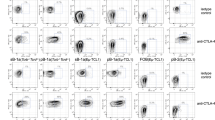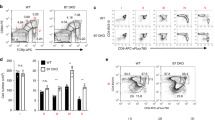Abstract
Regulatory T (Treg) cells play a critical role in the maintenance of tolerance. B-1a cells belong to a specific and functionally important B-cell subset that exerts its regulatory role through the production of IL-10. While IL-10 has been correlated with the induction of type 1 Treg (Tr1) cells or Tr1-like cells, whether IL-10-producing B-1a cells are able to induce Treg cells, especially the Tr1 lineage, is poorly understood. We have demonstrated that, similar to the reported B-2 cells, B-1a cells are able to convert naïve CD4+CD25− T cells into a subset of T cells with suppressive function, which we called ‘Treg-of-B1a' cells. Treg-of-B1a cells do not express Foxp3, but upregulate the Treg markers OX40, programmed death 1 (PD-1), inducible costimulator (ICOS) and IL-10R. Moreover, Treg-of-B1a cells do not express Foxp3 and produce high levels of IFN-γ and IL-10, but minimal amounts of IL-4; therefore, they resemble Tr1 cells. However, utilizing IL-10−/− mice, we showed that IL-10 was not involved in the induction of Treg-of-B1a cells. On the contrary, CD86-mediated costimulation was essential for B-1a cells to drive the induction of Treg-of-B1a cells. Finally, we demonstrated that, in contrast to the Treg cells generated by B-2 cells that mediate contact-dependent suppression, Treg-of-B1a cells suppress through secreting soluble factors. While Tr1 cells mediate suppression mainly through IL-10 or TGF-β secretion, Treg-of-B1a cells mediate suppression through an IL-10- and TGF-β-independent pathway. Together, these findings suggest that B-1a cells induce a functionally and phenotypically distinct Treg population that is dissimilar to the reported Foxp3+ Treg or Tr1 cells.
This is a preview of subscription content, access via your institution
Access options
Subscribe to this journal
Receive 12 digital issues and online access to articles
$119.00 per year
only $9.92 per issue
Buy this article
- Purchase on Springer Link
- Instant access to full article PDF
Prices may be subject to local taxes which are calculated during checkout






Similar content being viewed by others
References
Sakaguchi S, Yamaguchi T, Nomura T, Ono M . Regulatory T cells and immune tolerance. Cell 2008; 133: 775–787.
Mauri C, Bosma A . Immune regulatory function of B cells. Annu Rev Immunol 2012; 30: 221–241.
Bouaziz JD, Yanaba K, Tedder TF . Regulatory B cells as inhibitors of immune responses and inflammation. Immunol Rev 2008; 224: 201–214.
Hussain S, Delovitch TL . Intravenous transfusion of BCR-activated B cells protects NOD mice from type 1 diabetes in an IL-10-dependent manner. J Immunol 2007; 179: 7225–7232.
Mizoguchi A, Mizoguchi E, Takedatsu H, Blumberg RS, Bhan AK . Chronic intestinal inflammatory condition generates IL-10-producing regulatory B cell subset characterized by CD1d upregulation. Immunity 2002; 16: 219–230.
Mauri C, Gray D, Mushtaq N, Londei M . Prevention of arthritis by interleukin 10-producing B cells. J Exp Med 2003; 197: 489–501.
Vitale G, Mion F, Pucillo C . Regulatory B cells: evidence, developmental origin and population diversity. Mol Immunol 2010; 48: 1–8.
Tu W, Lau YL, Zheng J, Liu Y, Chan PL, Mao H et al. Efficient generation of human alloantigen-specific CD4+ regulatory T cells from naive precursors by CD40-activated B cells. Blood 2008; 112: 2554–2562.
Reichardt P, Dornbach B, Rong S, Beissert S, Gueler F, Loser K et al. Naive B cells generate regulatory T cells in the presence of a mature immunologic synapse. Blood 2007; 110: 1519–1529.
Amu S, Saunders SP, Kronenberg M, Mangan NE, Atzberger A, Fallon PG . Regulatory B cells prevent and reverse allergic airway inflammation via FoxP3-positive T regulatory cells in a murine model. J Allergy Clin Immunol 2010; 125: 1114–1124.e8.
Chu KH, Chiang BL . Regulatory T cells induced by mucosal B cells alleviate allergic airway hypersensitivity. Am J Respir Cell Mol Biol 2011; 46: 651–659.
Chen X, Jensen PE . Cutting edge: primary B lymphocytes preferentially expand allogeneic FoxP3+CD4 T cells. J Immunol 2007; 179: 2046–2050.
Morlacchi S, Soldani C, Viola A, Sarukhan A . Self-antigen presentation by mouse B cells results in regulatory T-cell induction rather than anergy or clonal deletion. Blood 2011; 118: 984–991.
DiLillo DJ, Matsushita T, Tedder TF . B10 cells and regulatory B cells balance immune responses during inflammation, autoimmunity, and cancer. Ann NY Acad Sci 2010; 1183: 38–57.
Fu CL, Chuang YH, Huang HY, Chiang BL . Induction of IL-10 producing CD4+ T cells with regulatory activities by stimulation with IL-10 gene-modified bone marrow derived dendritic cells. Clin Exp Immunol 2008; 153: 258–268.
Levings MK, Gregori S, Tresoldi E, Cazzaniga S, Bonini C, Roncarolo MG . Differentiation of Tr1 cells by immature dendritic cells requires IL-10 but not CD25+CD4+ Tr cells. Blood. 2005; 105: 1162–1169.
Bacchetta R, Gregori S, Roncarolo MG . CD4+ regulatory T cells: mechanisms of induction and effector function. Autoimmun Rev 2005; 4: 491–496.
Ahangarani RR, Janssens W, VanderElst L, Carlier V, VandenDriessche T, Chuah M et al. In vivo induction of type 1-like regulatory T cells using genetically modified B cells confers long-term IL-10-dependent antigen-specific unresponsiveness. J Immunol 2009; 183: 8232–8243.
O'Garra A, Chang R, Go N, Hastings R, Haughton G, Howard M . Ly-1 B (B-1) cells are the main source of B cell-derived interleukin 10. Eur J Immunol 1992; 22: 711–717.
Reichardt P, Dornbach B, Gunzer M . The molecular makeup and function of regulatory and effector synapses. Immunol Rev 2007; 218: 165–177.
Fujio K, Okamura T, Yamamoto K . The family of IL-10-secreting CD4+ T cells. Adv Immunol 2010; 105: 99–130.
Croft M, So T, Duan W, Soroosh P . The significance of OX40 and OX40L to T-cell biology and immune disease. Immunol Rev 2009; 229: 173–191.
Fife BT, Pauken KE . The role of the PD-1 pathway in autoimmunity and peripheral tolerance. Ann NY Acad Sci 2011; 1217: 45–59.
Chen X, Subleski JJ, Kopf H, Howard OM, Mannel DN, Oppenheim JJ . Cutting edge: expression of TNFR2 defines a maximally suppressive subset of mouse CD4+CD25+FoxP3+ T regulatory cells: applicability to tumor-infiltrating T regulatory cells. J Immunol 2008; 180: 6467–6471.
Han Y, Guo Q, Zhang M, Chen Z, Cao X . CD69+ CD4+ CD25− T cells, a new subset of regulatory T cells, suppress T cell proliferation through membrane-bound TGF-beta 1. J Immunol 2009; 182: 111–120.
Weiss EM, Schmidt A, Vobis D, Garbi N, Lahl K, Mayer CT et al. Foxp3-mediated suppression of CD95L expression confers resistance to activation-induced cell death in regulatory T cells. J Immunol 2011; 187: 1684–1691.
Wing K, Onishi Y, Prieto-Martin P, Yamaguchi T, Miyara M, Fehervari Z et al. CTLA-4 control over Foxp3+ regulatory T cell function. Science 2008; 322: 271–275.
Ji HB, Liao G, Faubion WA, Abadia-Molina AC, Cozzo C, Laroux FS et al. Cutting edge: the natural ligand for glucocorticoid-induced TNF receptor-related protein abrogates regulatory T cell suppression. J Immunol 2004; 172: 5823–5827.
Akbari O, Freeman GJ, Meyer EH, Greenfield EA, Chang TT, Sharpe AH et al. Antigen-specific regulatory T cells develop via the ICOS–ICOS-ligand pathway and inhibit allergen-induced airway hyperreactivity. Nat Med 2002; 8: 1024–1032.
Chaudhry A, Samstein RM, Treuting P, Liang Y, Pils MC, Heinrich JM et al. Interleukin-10 signaling in regulatory T cells is required for suppression of Th17 cell-mediated inflammation. Immunity 2011; 34: 566–578.
Miyara M, Sakaguchi S . Natural regulatory T cells: mechanisms of suppression. Trends Mol Med 2007; 13: 108–116.
Barrat FJ, Cua DJ, Boonstra A, Richards DF, Crain C, Savelkoul HF et al. In vitro generation of interleukin 10-producing regulatory CD4+ T cells is induced by immunosuppressive drugs and inhibited by T helper type 1 (Th1)- and Th2-inducing cytokines. J Exp Med 2002; 195: 603–616.
Noh G, Lee JH . Regulatory B cells and allergic diseases. Allergy Asthma Immunol Res 2011; 3: 168–177.
Zhong X, Gao W, Degauque N, Bai C, Lu Y, Kenny J et al. Reciprocal generation of Th1/Th17 and Treg cells by B1 and B2 B cells. Eur J Immunol 2007; 37: 2400–2404.
Wu K, Bi Y, Sun K, Wang C . IL-10-producing type 1 regulatory T cells and allergy. Cell Mol Immunol 2007; 4: 269–275.
Battaglia M, Gregori S, Bacchetta R, Roncarolo M . Tr1 cells: from discovery to their clinical application. Semin Immunol 2006; 18: 120–127.
Margry B, Wieland WH, van Kooten PJ, van Eden W, Broere F . Peritoneal cavity B-1a cells promote peripheral CD4+ T-cell activation. Eur J Immunol 2013; 43: 2317–2326.
Labadi A, Balogh P . Differential preferences in serosal homing and distribution of peritoneal B-cell subsets revealed by in situ CFSE labeling. Int Immunol 2009; 21: 1047–1056.
Gao J, Ma X, Gu W, Fu M, An J, Xing Y et al. Novel functions of murine B1 cells: active phagocytic and microbicidal abilities. Eur J Immunol 2012; 42: 982–992.
Parra D, Rieger AM, Li J, Zhang YA, Randall LM, Hunter CA et al. Pivotal advance: peritoneal cavity B-1 B cells have phagocytic and microbicidal capacities and present phagocytosed antigen to CD4+ T cells. J Leukoc Biol 2012; 91: 525–536.
Hand TW, dos Santos LM, Bouladoux N, Molloy MJ, Pagan AJ, Pepper M et al. Acute gastrointestinal infection induces long-lived microbiota-specific T cell responses. Science 2012; 337: 1553–1556.
Acknowledgements
This work was supported, in part, by a grant, NHRI-EX102-10253SI, from the National Health Research Institute, Republic of China. Supplementary Information accompanies the paper on Cellular & Molecular Immunology's website. (http://www.nature.com/cmi).
Author information
Authors and Affiliations
Corresponding author
Ethics declarations
Competing interests
The authors declare no financial or commercial conflicts of interest.
Additional information
Supplementary Information accompanies the paper on Cellular & Molecular Immunology's website. (http://www.nature.com/cmi).
Supplementary information
Rights and permissions
About this article
Cite this article
Hsu, LH., Li, KP., Chu, KH. et al. A B-1a cell subset induces Foxp3− T cells with regulatory activity through an IL-10-independent pathway. Cell Mol Immunol 12, 354–365 (2015). https://doi.org/10.1038/cmi.2014.56
Received:
Revised:
Accepted:
Published:
Issue Date:
DOI: https://doi.org/10.1038/cmi.2014.56
Keywords
This article is cited by
-
FoxO1 suppresses IL-10 producing B cell differentiation via negatively regulating Blimp-1 expression and contributes to allergic asthma progression
Mucosal Immunology (2022)
-
B cells induced by Schistosoma japonicum infection display diverse regulatory phenotypes and modulate CD4+ T cell response
Parasites & Vectors (2020)
-
Recent advances in regulatory T cells induced by B cells
Cellular & Molecular Immunology (2018)
-
Regulatory T cells induced by B cells: a novel subpopulation of regulatory T cells
Journal of Biomedical Science (2017)
-
Regulation of B-1a cells: another novel function of the basic helix-loop-helix transcriptional regulator BHLHE41
Cellular & Molecular Immunology (2017)



